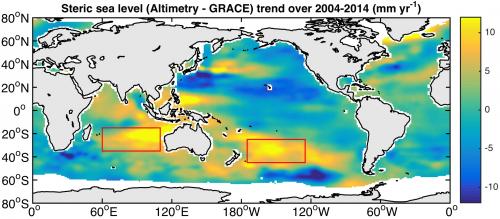Abstract's details
Assessing regional deep-ocean warming from satellite and in situ data
Event: 2015 Ocean Surface Topography Science Team Meeting
Session: Science III: Large scale and global change ocean processes: the ocean's role in climate
Presentation type: Poster
The observed Earth’s net energy imbalance requires that all extra heat is stored in the climate system, mostly in the World Ocean, which is the dominant reservoir of heat uptake. Sea level, as a natural indicator of the full-depth ocean heat content, has been accurately measured by satellite altimetry since 1992. Measurements of ocean mass variations provided by the GRACE twin satellites since 2002 can be subtracted from altimetric Sea Surface Height (SSH) to derive steric changes (due to temperature and salinity) of sea level. The advent of Argo profiling floats has made available global observations of temperature for depths above 2000 m since 2003. Recent analysis of globally averaged quantities over the 2005-2013 time interval has shown no significant deep-ocean warming below 2000 m depth. In the present work, we combine satellite and in-situ data to address the regional redistribution of heat content and investigate whether and how local processes lead to accumulation of heat at deeper layers. Our analysis shows that the largest trends of the steric sea level over the 2004-2014 time interval are in the South Indian and South Pacific Oceans (see figure). In the South Indian Ocean, warming is limited to the upper 1000 m, while in the South Pacific Ocean a significant warming is observed between 1000 and 2000 m depth. Indirect estimates (difference between the satellite and in situ estimates of the steric sea level change) show a significant warming below 2000 m depth in the South Pacific Ocean; the linear trend of the steric SSH linked to this warming is approximately equal to the linear trend of the steric SSH over the upper 2000 m. We further show that the deep-ocean (below 2000 m) warming in the South Pacific Ocean was caused by an increased Ekman convergence associated with the strengthening of westerly winds over the Southern Ocean and trade winds in the South Pacific.

Contribution: Poster1_OSTST_Oct2015.pdf (pdf, 6904 ko)
Back to the list of abstract